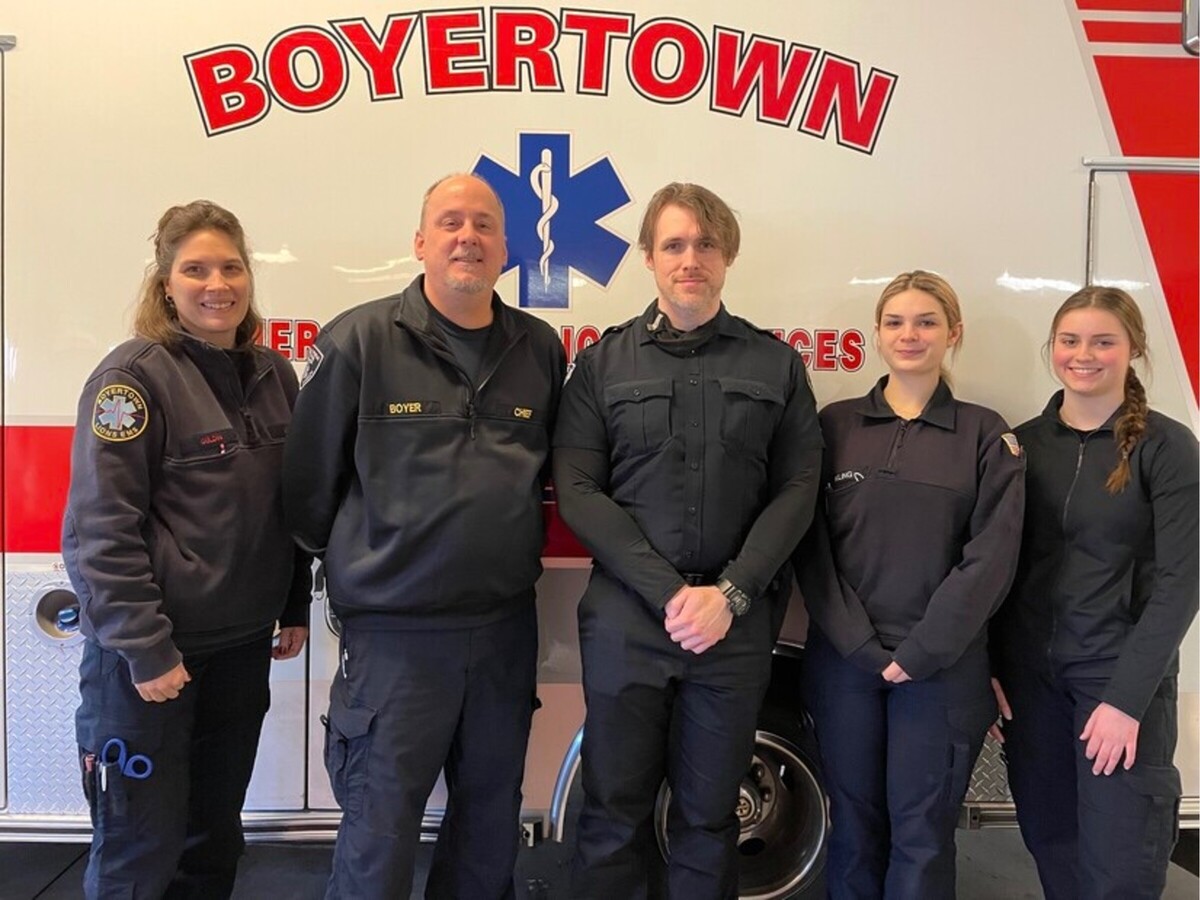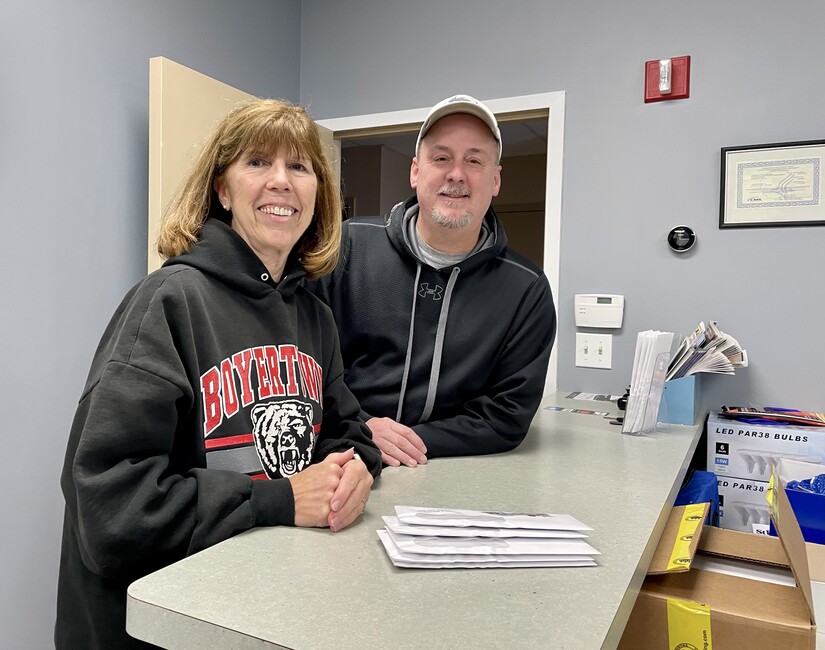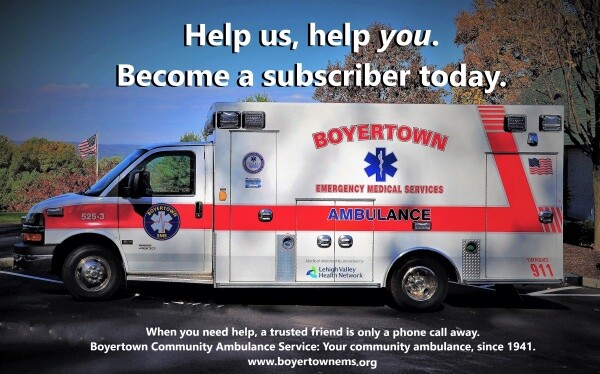Image


During this season of giving, the Boyertown Community Ambulance Service (BCAS) is offering subscribers a different type of gift: the peace of mind that comes with knowing that someone who may be able to save your life is just one call away.
Jim Boyer, Boyertown Emergency Medical Service (EMS) Chief explains, “Last week we saved a woman’s life. She placed the 9-1-1 call herself, but when the ambulance crew arrived, she was unresponsive and in cardiac arrest.” The local fire company was also dispatched and had begun CPR. When the EMS arrived, Boyer continues, “We immediately began life-saving protocols and halfway to the hospital, we got a pulse. We lost her a second time and had to bring her back again.”
Reflecting back on this life-changing experience, he adds, “Everything worked. She survived.”
Obviously not as significant as saving lives, but still worth considering is that in addition to saving a loved one's life, a subscription to BCAS – which runs $95 for individuals and $115 for families with children under 18 – can save you hundreds of dollars. Those who purchase subscriptions are not billed for the costs associated with calling and using the ambulance, whose service area includes includes the Borough of Boyertown, Colebrookdale Township, and the majority of both Douglass/Berks and Earl Townships.

While some communities are exploring the concept, unlike the local police, BCAS is not funded through local taxes. Yet, area residents rely on the ambulance service all the same. Consequently, Melanie Roth, who became president of the Ambulance Board of Directors in July, has made strengthening BCAS’ revenue stream one of the top priorities of her supportive and hardworking 13-member Board.
She notes that the cost for an ambulance responding to a 9-1-1 call averages from $800 -$1500, depending on whether the patient requires advanced life support services. “People think that their Medicare or other health insurance pays that cost, but in reality, your insurance most often pays only about $400 - $500,” Roth shares. “The difference is then billed to the patient.”
Some people are unable to afford the additional cost. Others, unfortunately, choose not to pay their portion. Yet other problems can occur when insurance companies send a check to the patient, rather than to the ambulance service. “That person is supposed to send the check to us,” explains Roth, “but sadly, not everyone understands that process.”
In some cases, Medicare or other insurance companies will decide that an ambulance call was not "medically necessary" and provide no payment at all– even though an ambulance was dispatched to respond to the call they received.
In all of these situations, BCAS ends up absorbing the costs.
The municipalities served by the Boyertown Ambulance contribute with donations, as do individuals and local businesses. Some businesses are now purchasing subscriptions to cover their employees while at work. But without revenue from individual and family subscriptions, BCAS risks running a deficit.
Revenue from subscriptions is essential for Boyertown Community Ambulance Service to achieve their most important goal: ensuring that BCAS can provide the best possible care and outcomes. That means investing in the latest cutting-edge ambulances, medical equipment, and also in persistently updating training and certification for the team of 30 employees, consisting of 10 full time and 20 part-time or per diem.
“I’ve been astonished by the cost of the equipment,” exclaims Roth. The average ambulance runs $250,000... just for the ambulance. But then other equipment and items must be added, from patient loading systems to heart monitors to drugs – all of which quickly adds up. A good quality heart monitor is priced around $45,000. The service must also cover the costs to maintain its fleet, which includes three ambulances plus a utility vehicle, and its building. For example, a significant area of the macadam outside the building currently needs to be rebuilt.
In some instances, community groups have helped cover the costs of specialized equipment. Roth cites a generous donation from the Ladies Auxiliary at Friendship Hook and Ladder, that helped BCAS purchase a $3,500 Video Laryngoscope tool that enables a higher success rate intubating patients. Also, proceeds from a recent choral presentation of the Messiah, sponsored by St. John's Evangelical Lutheran Church, are being donated to BCAS.
Equally important is having sufficient top notch medical staff. For example, Roth notes that last year BCAS was the first community ambulance organization in the state to receive a special certification in providing care for autistic children.
Boyer points out a certificate indicating that BCAS has earned Lifeline EMS Gold Plus Status for "demonstrating continued success in providing the most up to date evidence based treatment. We are fortunate in the Boyertown area to have such great resources in place,” Boyer shares with pride.
 Melanie Roth, Board President, and Jim Boyer, Emergency Medical Services Chief, meet for a recent Saturday work session.
Melanie Roth, Board President, and Jim Boyer, Emergency Medical Services Chief, meet for a recent Saturday work session.In some towns, where community support has waned, residents may be forced to rely on outside organizations to provide an ambulance.
Referring back to the resident who BCAS recently revived, Boyer states: “The woman’s chances of surviving were greater because our ambulance was available. The delay of a more distant response could have resulted in a far worse outcome.”
“My great fear, and it is starting to happen some places, is that when local ambulances cannot be sustained, large hospital groups come into the area,” Roth adds. “Hospitals are expanding their ambulance services because they can absorb the revenue losses.” But relying on these third parties comes with its own cost: the possibility of extended waiting times for life-saving help.
Communities without a local ambulance service also lose the peace of mind that comes with knowing their loves ones are being cared for by people they know and trust. Roth explains, "Because we are local, to us, you aren't just a number. You're our neighbor, a family member, a co-worker."
"We are more involved and more compassionate. This is our community, and these are our people. It is personal to us," Boyer adds. Proceeds from the sale of subscriptions help make this possible.
“We never know what life will bring. Young people may think they won’t need an ambulance. They may think it is only for older folks, but no one is immune from sickness and injuries. You may not need it this year, but your purchase of a subscription will help someone who does. When you need it, someone else's subscription purchase will contribute to helping you," Boyer concludes.
Envelopes with subscription information have been mailed to community members, but you can obtain an annual subscription online at BCAS' website, or contact BCAS at info@boyertownems.org and 610-367-2330 for more information.
Donations can also be made online and are received with gratitude. They may be designated for a particular use and/or made in honor or in memory of someone.
 Your subscriptions help BCAS help the community. Subscribe today!
Your subscriptions help BCAS help the community. Subscribe today!